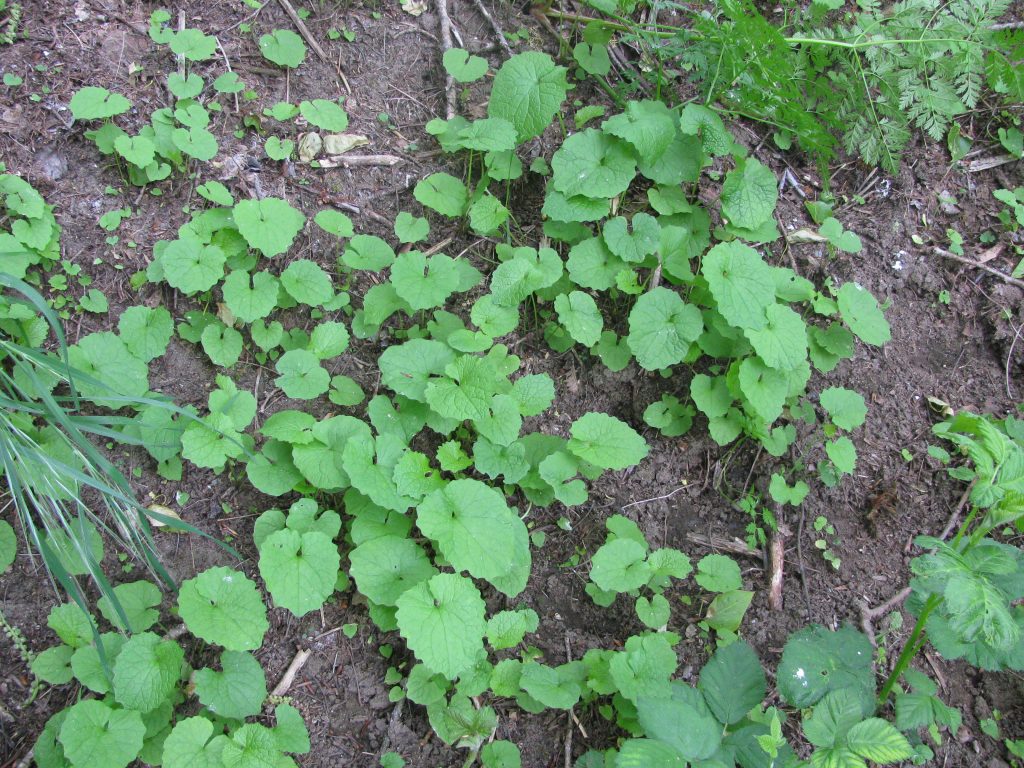
Garlic mustard rosette 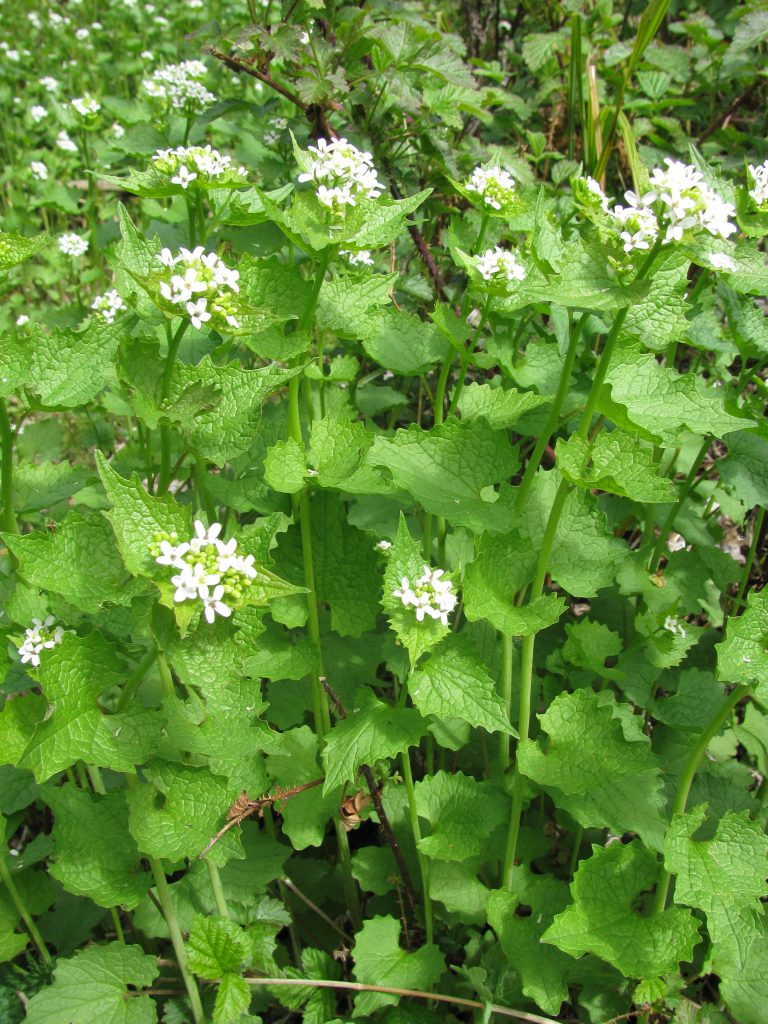
Garlic mustard flowers 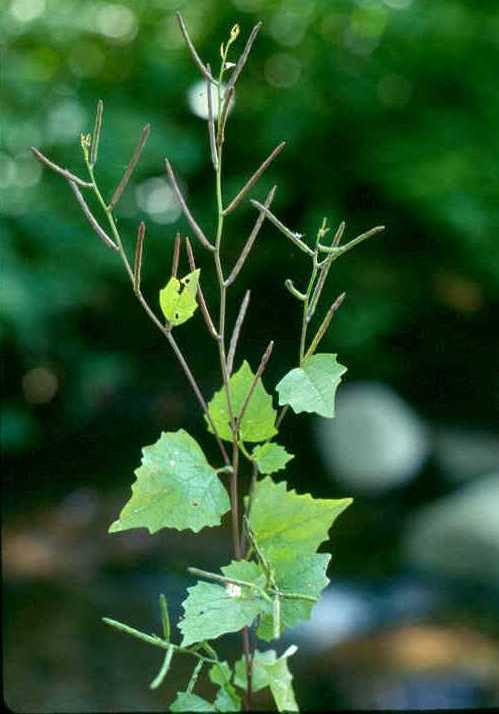
Garlic mustard seed pods 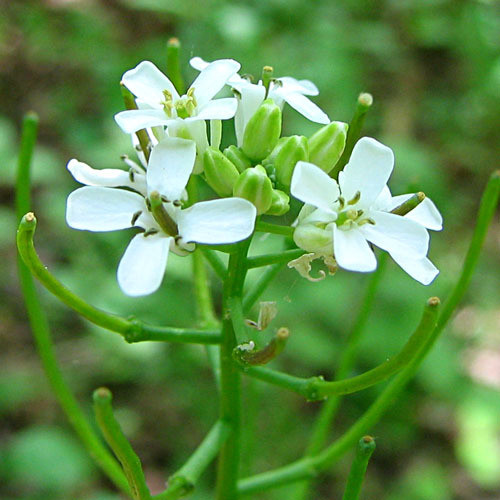
Garlic mustard flowers 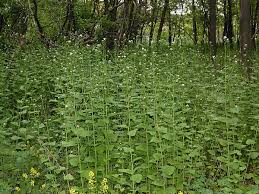
Garlic mustard
Common Names: garlic mustard, Jack-by-the-hedge, hedge garlic,
sauce-alone, jack-by-the-hedge, poor man’s mustard, jack-in-the-bush, garlic root, garlicwort, mustard root
Scientific Name: Alliaria petiolata (syns. Alliaria alliaria)
How to identify: Garlic mustard is a biennial herb that ranges from 12 to 48 inches in height as an adult. Leaves and stems emit the distinctive odor of onion or garlic when crushed. First year plants are a rosette of 3 or 4 kidney-shaped, scallop edged leaves. Second-year plants generally produce one or two flowering stems with numerous white flowers that have four separate petals forming a cross. The plant produces black, oblong seeds in 1 to 2 ½ inch slender pods called siliques that radiate from the stem just below the flowers. Its slender taproot is “s”-shaped at the top.
Native Look-A-Likes: During the rosette stage, garlic mustard resembles Viola ssp., and several plants in the Saxifrage family, including Tellima grandiflora (fringecup) and Tolmiea menziesii (piggy-back plant). A distinguishing characteristic of the saxifrage are the presence of long hair, particularly on the leaf stems – which mature garlic mustard does not have.
When to find it: Garlic mustard can be found throughout the year, but it is most easily recognizable in the spring when second year plants are in bloom.
Where to find it: Look in the partial or filtered light of forest understory or edges. It is also found in shaded roadsides, urban areas, riparian areas, along hiking trails, and on agricultural lands.
Description: Garlic mustard is a known aggressive plant newly introduced to Oregon and expected to become widespread if no action is taken. Introduced to the East coast from Europe, this plant now carpets forest understories of the Northeast and Midwest and continues to spread westward across the United States. In Oregon, garlic mustard is established in the Portland and The Columbia Gorge and a new population was recently found in the Rogue River valley.
As one of the few invasive plants capable of dominating undisturbed forests understories, garlic mustard has the potential to alter forest communities. It can change the tree composition of the forest by suppressing hardwoods such as maples and ashes. An abundance of garlic mustard can alter the suitability of habitats for native birds, mammals, and amphibians.
Garlic mustard is a biennial that can be either self-pollinated or cross-pollinated. Each plant can produce hundreds of seeds, which germinate after a period of dormancy in late February or early March until May. The seeds are believed to be primarily dispersed by human activity, but are also spread by flowing water, birds, and rodents, and may possibly even catch a ride on the fur of larger animals, such as deer.
Since Garlic Mustard has no known natural enemies, is self-fertile, and difficult to eliminate, the most effective control method is to prevent its initial establishment. Burning, herbicides, or cutting are often used to control large existing populations and biocontrol methods are being developed.
How to treat it:
- Small patches can be manually removed by hand-pulling or spraying.
- Pulled material will complete flowering and set seed, so be sure to bag everything .
- Mowed plants will grow and set seed, so don’t rely entirely on mowing as a method of control.
- Document the site (location, photos, dates, treatments) and report findings.
Noxious Weed Listings:
- State of Oregon: Class B
- Jackson & Josephine County CWMAs: Class A
Additional Resources:
Nuzzo, Victoria, Natural Area Consultants. “Element Stewardship Abstract for Allaria petiolata (Allaria officinalis) Garlic Mustard.” The Nature Conservancy
Stinson KA, Campbell SA, Powell JR, Wolfe BE, Callaway RM, et al. (2006) Invasive plant suppresses the growth of native tree seedlings by disrupting belowground mutualisms. PLoS Biol 4(5): e140. DOI: 10.1371/journal.pbio.0040140
https://www.oregon.gov/oda/shared/Documents/Publications/Weeds/garlicmustardProfile.pdf